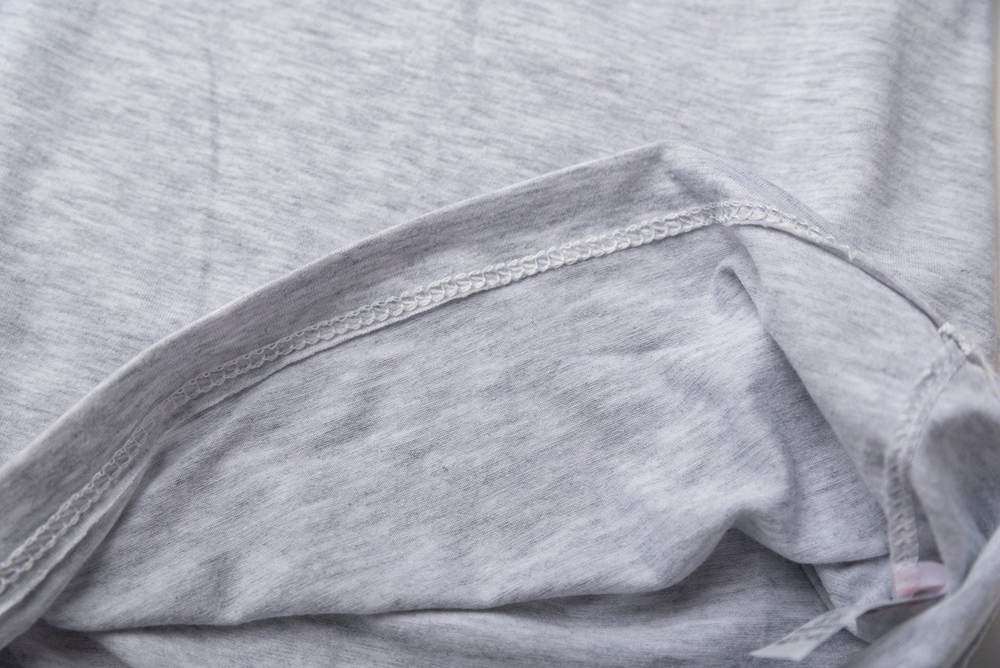
Hemming a t-shirt is a simple way to adjust the length and give your shirt a more tailored look. With just a few basic sewing skills and supplies, you can easily hem a t-shirt in no time. This article will walk you through 10 easy methods for hemming t-shirts, from hand sewing to using iron-on adhesive. We’ll also provide tips on measuring for the perfect hem length and how to get a professional finish. Read on to learn how to hem t-shirts like a pro!
Table of Contents
Materials Needed
Before you start hemming, you’ll need to gather a few supplies:
- T-shirt to hem
- Ruler or measuring tape
- Fabric scissors
- Pins
- Hand-sewing needle
- Matching sewing thread
- Iron-on hem tape (optional)
- Sewing machine (optional)
How to Measure for Hem Length
Properly measuring for the hem is an important first step for achieving the right length on your tee. Here’s how to measure correctly:
- Put on the t-shirt and stand straight with your arms at your sides. Have a friend mark the desired length with pins or chalk.
- For a more casual hem, mark 1-2 inches above the hip bone. For a dressier hem, mark just below the hip bone.
- Remove the shirt and lay it flat. Measure the depth of the marked hem, from the pinned mark to the raw edge. This is how much fabric you’ll need to fold up.
- Add an extra 1/4 inch to allow for seam finishing. This is the total length you’ll fold and sew for the hem.
10 Easy Ways to Hem a T-Shirt

1. Hand Sew a Blind Hem
The blind hem creates an invisible hem line on the outside of the garment. This method takes more time but results in a seamless finish.
Instructions:
- Clean finish the raw edge of the hem allowance by zigzag stitching, pinking, or turning under 1/4 inch.
- Press under the hem allowance to the desired length.
- Fold the t-shirt hem back to the wrong side, enclosing the folded hem edge inside. Pin.
- From the wrong side, hand sew tiny stitches along the fold, catching a few threads of the t-shirt fabric on each stitch.
- Remove pins and press the hem.
2. Sew a Machine Blind Hem
For a quicker blind hem, use a sewing machine’s built-in blind hem stitch. This gives the same invisible look on the outside.
Instructions:
- Clean finish the raw edge of the hem allowance.
- Press under the hem allowance to the desired length.
- Fold the hem back to the wrong side, enclosing the folded edge inside. Pin.
- From the wrong side, machine blind hem along the fold, adjusting the stitch width as needed.
- Remove pins and press the hem.
3. Top Stitch Hem
Top stitching shows stitching on the outside of the project. Use a straight or decorative stitch for a cute visible hem.
Instructions:
- Clean finish the raw edge of the hem allowance.
- Press under the hem allowance to the desired length.
- Edgestitch along the inner folded edge of the hem, visible from the right side.
- Remove pins and press the hem.
4. Machine Zigzag Hem
Zigzag stitching creates a bold hem finish while preventing the raw edge from unraveling. Change zigzag width and length for different looks.
Instructions:
- Trim hem allowance to desired depth, cutting off fraying edges.
- On the wrong side, zigzag stitch close to raw edge to create a clean finish.
- Turn hem to inside along zigzag stitching and press. Pin in place.
- Edgestitch close to inner fold through all layers to secure.
5. Double Needle Hem
This method uses a double needle on a sewing machine to create two parallel rows of visible topstitching. Fun hem for t-shirt upcycling projects.
Instructions:
- Clean finish raw edge of the hem allowance.
- Press under the hem allowance to the desired length.
- Thread the sewing machine with two spools of matching thread. Insert a double needle.
- Sew hem allowance using a straight stitch, with double topstitching visible on the right side.
- Remove pins and press the hem.
6. Iron-On Adhesive Hem
Hemming tape bonded with heat offers a no-sew hem option. Great for quick hems on knits like t-shirts.
Instructions:
- Clean finish the raw edge of the hem allowance.
- Press under hem allowance to desired length and pin.
- Place hem tape against the wrong side of the fold, paper side up. Iron to bond tape to hem.
- Remove paper backing after cooled.
- On the right side, press along the adhesive hem to set the bond.
7. Hand Sew a Catch Stitch
Also called a hemstitch, the catch stitch is made up of small diagonal stitches that catch a thread or two of the hem allowance. It has a neat, tailored look.
Instructions:
- Clean finish the raw edge of the hem allowance.
- Press under the hem allowance to the desired length.
- From the right side, hand sew small diagonal stitches across hem, catching a thread or two each time.
- Remove pins and press the hem.
8. Fusible Web Hem
Fusible webbing offers another no-sew option for hemming knits like t-shirts. Press it in place for an instant bond.
Instructions:
- Clean finish raw edge of the hem allowance.
- Press under the hem allowance to the desired length and pin.
- Place fusible web against the wrong side of the fold. Iron to fuse in place.
- Remove pins. The hem will now be bonded.
- For added strength, stitch close to the inner folded edge.
9. Machine Straight Stitch Hem
Straight stitching is a basic hem sewn on the sewing machine. Quick to sew and removes fraying edges.
Instructions:
- Trim hem allowance to desired depth, cutting off fraying edges.
- Fold hem allowance up to desired length, wrong sides together. Pin.
- Edgestitch folded hem allowance using a straight stitch on the sewing machine. Remove pins.
- For extra durability, stitch a second row of straight stitching.
10. Ladder Stitch Hem
This hand sewing stitch creates an invisible hem from the right side, like a blind hem. It has a natural look on t-shirt hems.
Instructions:
- Clean finish raw edge of the hem allowance.
- Press under hem allowance to desired length and pin.
- Thread hand-sewing needle and knot end. Hide knot between hem layers.
- From the right side, take tiny straight stitches perpendicularly across the hem. Keep stitches loose.
- Every few stitches, “climb” up across the ladder of thread. Keep stitches barely visible.
- Finish off with knot between hem layers. Remove pins and press.
Hemming Tips
- For curved hems, clip seam allowance at regular intervals to help ease fullness around curves.
- Use pinking shears on seam allowances to help prevent fraying edges.
- Reduce bulk by grading seam allowances, trimming the bottom one slightly narrower.
- For knits like t-shirts, use a stretch stitch like zigzag to allow the hem to stretch with the fabric.
- If fabric is very bulky, trim away excess to reduce bulk before hemming.
Common Hem Lengths for T-Shirts
| Hem Type | Length |
|---|---|
| Casual Daily Wear | 1-2 inches above hip bone |
| Fitted | 1-2 inches below hip bone |
| Cropped | 1-3 inches above hip bone |
| Extra Long | 4-6 inches below hip bone |
FAQ
What’s the easiest way to hem a t-shirt?
The easiest hemming methods involve fusible products, either hem tape or web. These are ironed on for a no-sew hem.
Should I hem t-shirts by hand or machine?
It’s quickest to hem t-shirts by machine, but hand hemming like a blind hem gives the most invisible look. Choose your method based on time and the finish you prefer.
How do I keep knit hems from stretching out?
Use interfacing on the hem allowance to add stability and prevent stretching. For sewing, a zigzag stitch or twin needle topstitch will allow stretch while securing the hem.
How much hem allowance should I leave on a t-shirt?
For most light to medium-weight knits, leave a hem allowance of 1/2 to 1 inch. This provides enough fabric to enclose the raw edge without adding bulk.
What stitch length should I use?
For machine hemming, use a longer 2.5-3 mm stitch length. For hand hemming, take very tiny stitches just 1-2 mm in length to keep them invisible.